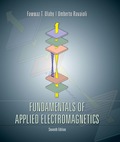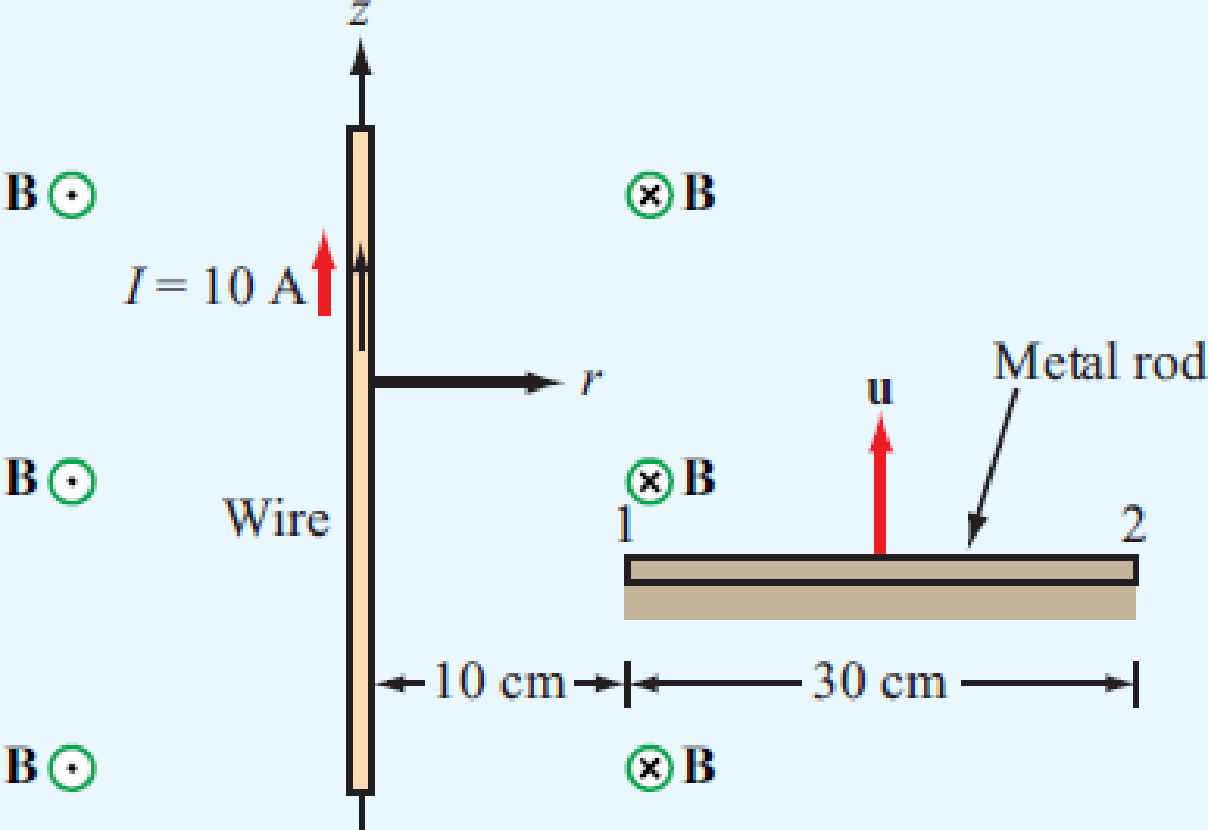
Fundamentals of Applied Electromagnetics (7th Edition)
7th Edition
ISBN: 9780133356984
Author: ULABY
Publisher: PEARSON
expand_more
expand_more
format_list_bulleted
Concept explainers
Textbook Question
Chapter 6.4, Problem 5CQ
Is the current flowing in the rod of Fig. 6-10 a steady current? Examine the force on a charge q at ends 1 and 2 and compare.

Expert Solution & Answer
Want to see the full answer?
Check out a sample textbook solution
Students have asked these similar questions
b) Another periodic waveform is defined by
T
c)
g(t)=
T
with g(t+mT) = g(t) and m is an integer.
(i)
Sketch g(t) over two full cycles in the time domain, labelling the axes.
(ii)
Derive the formulae for the complex Fourier coefficients c₁ for g(t).
For a periodic waveform h(t), if its complex Fourier coefficients are
T
T
when n is odd
T
2n²²
T
4nn
when n is even and not zero
4nn
please derive the first five non-zero terms of the real Fourier series for h(t).
Q3)α) f(t) = (-+- 1 Isto
f(t+mT) = f(t).
L+- I Ost ST
integer
(i) sketch f(t) 2 full cycles time domain. (labelling the axis).
(ii) Derive the formula for the real fourier Coefficients
(i) Real Fourier series f(t), first 5 non-terms.
an
bn for f(t).
Q3.
a)
A periodic waveform is defined by
T
3 0≤t<
f(t) =
SI
Chapter 6 Solutions
Fundamentals of Applied Electromagnetics (7th Edition)
Ch. 6.2 - Explain Faradays law and the function of Lenzs...Ch. 6.2 - Prob. 2CQCh. 6.2 - Prob. 3CQCh. 6.2 - For the loop shown in Fig. 6-3, what is Vemftr if...Ch. 6.2 - Suppose that the loop of Example 6-1 is replaced...Ch. 6.4 - Suppose that no friction is involved in sliding...Ch. 6.4 - Is the current flowing in the rod of Fig. 6-10 a...Ch. 6.4 - For the moving loop of Fig. 6-9, find I when the...Ch. 6.4 - Suppose that we turn the loop of Fig. 6-9 so that...Ch. 6.5 - Contrast the operation of an ac motor with that of...
Ch. 6.5 - Prob. 7CQCh. 6.5 - Prob. 8CQCh. 6.7 - A poor conductor is characterized by a...Ch. 6.8 - When conduction current flows through a material,...Ch. 6.8 - Verify that the integral form of Ampres law given...Ch. 6.10 - Explain how the charge continuity equation leads...Ch. 6.10 - How long is the relaxation time constant for...Ch. 6.10 - Determine (a) the relaxation time constant and (b)...Ch. 6.11 - Prob. 7ECh. 6 - The switch in the bottom loop of Fig. P6.1 is...Ch. 6 - The loop in Fig. P6.2 is in the xy plane and B =...Ch. 6 - A coil consists of 100 turns of wire wrapped...Ch. 6 - A stationary conducting loop with an internal...Ch. 6 - A circular-loop TV antenna with 0.02 m2 area is in...Ch. 6 - The square loop shown in Fig. P6.6 is coplanar...Ch. 6 - The rectangular conducting loop shown in Fig. P6.7...Ch. 6 - Prob. 8PCh. 6 - Prob. 9PCh. 6 - A 50 cm long metal rod rotates about the z axis at...Ch. 6 - The loop shown in P6.11 moves away from a wire...Ch. 6 - The electromagnetic generator shown in Fig. 6-12...Ch. 6 - The circular, conducting, disk shown in Fig. P6.13...Ch. 6 - The plates of a parallel-plate capacitor have...Ch. 6 - A coaxial capacitor of length l = 6 cm uses an...Ch. 6 - The parallel-plate capacitor shown in Fig. P6.16...Ch. 6 - In wet soil, characterized by = 102 (S/m), r = 1,...Ch. 6 - An electromagnetic wave propagating in seawater...Ch. 6 - At t = 0, charge density v0 was introduced into...Ch. 6 - If the current density in a conducting medium is...Ch. 6 - Prob. 21PCh. 6 - If we were to characterize how good a material is...Ch. 6 - The electric field of an electromagnetic wave...Ch. 6 - The magnetic field in a dielectric material with ...Ch. 6 - Given an electric field E=xE0sinaycos(tkz), where...Ch. 6 - The electric field radiated by a short dipole...Ch. 6 - A Hertzian dipole is a short conducting wire...Ch. 6 - In free space, the magnetic field is given by...Ch. 6 - The magnetic field in a given dielectric medium is...
Knowledge Booster
Learn more about
Need a deep-dive on the concept behind this application? Look no further. Learn more about this topic, electrical-engineering and related others by exploring similar questions and additional content below.Similar questions
- Q2. a) Sketch the following waveform f(t)=Vo -1/2≤t≤1/2 =0 otherwise and show that its Fourier transform is 2V ωτ ωτ F(s)-sinotsinc) 2 Use this result to sketch a fully labelled graph of the amplitude spectrum of a single square voltage pulse, of amplitude 24V and pulse width 1.4μs, using units of Hz for the frequency axis. (Note: graph paper is not required - a clear, fully-labelled sketch is adequate).arrow_forwardc) Another periodic waveform is defined by 4t g(t)= 0≤tarrow_forwardQ1. a) A periodic waveform is defined by f(t)= 3 0≤tarrow_forwardI have 50mV in the function generator with 10kHz. Does the connection and reading seem about right? I need to read output voltage.arrow_forwardThe solution sent previously is incorrect; I need the correct solution. An antenna with a radiation impedance of 75+j10 ohm, with 10 ohm loss resistance, is connected to a generator with open-circuit voltage of 12 v and an internal impedance of 20 ohms via a 2/4-long transmission line with characteristic impedance of 75 ohms. (a) Draw the equivalent circuit (c) Determine the power radiated by the antenna.arrow_forwardFIU Quiz: Take Quiz 1: Chapter 1 courses/217034/quizzes/1318866/take S M Inbox (40,079) - josesanchez11: X + 2. For the circuit in figure below: (a) Identify and label all distinct nodes. (b) Which of those nodes are extraordinary nodes? (c) Identify all combinations of 2 or more circuit elements that are connected in series. (d) Identify pairs of circuit elements that are connected in parallel. ww 25 Ω 12 V +1 40 Ω 10 Ω 60 Ω ww 2502 Ω 30 Ω 20 Ω 15 Ω ww Upload Choose a File X legearrow_forwardSolve the octic polynomial 2s⁸+s⁷+2s⁶-31s⁴-16s³-32s²-160=0 Only expert should attempt this question,no artificial intelligencearrow_forwardFour isotropic point sources placed along z-axis as shown. Assuming the current coefficient of element 1 and 2 is 1, while of 3 and 4 is -1. Derive array factor, then find null directions (d=2/2) d/2 di2 #4arrow_forwardExplain the operation of the circuit if M contacts 2 and 3 do not close.arrow_forwardQ5: Given the following system: น -3 y= [4 -2] +3u Generate a model with states that are the sum and difference of the original states.arrow_forwardFind the state transition matrix. for the system whose simulation diagram is shown below: Uz x2 K 3 K=16arrow_forwardQ3: Find the state-space representation for the system given by:- + 16 + ၃- တိုင်း၍ရား +arrow_forwardarrow_back_iosSEE MORE QUESTIONSarrow_forward_iosRecommended textbooks for you
 Introductory Circuit Analysis (13th Edition)Electrical EngineeringISBN:9780133923605Author:Robert L. BoylestadPublisher:PEARSON
Introductory Circuit Analysis (13th Edition)Electrical EngineeringISBN:9780133923605Author:Robert L. BoylestadPublisher:PEARSON Delmar's Standard Textbook Of ElectricityElectrical EngineeringISBN:9781337900348Author:Stephen L. HermanPublisher:Cengage Learning
Delmar's Standard Textbook Of ElectricityElectrical EngineeringISBN:9781337900348Author:Stephen L. HermanPublisher:Cengage Learning Programmable Logic ControllersElectrical EngineeringISBN:9780073373843Author:Frank D. PetruzellaPublisher:McGraw-Hill Education
Programmable Logic ControllersElectrical EngineeringISBN:9780073373843Author:Frank D. PetruzellaPublisher:McGraw-Hill Education Fundamentals of Electric CircuitsElectrical EngineeringISBN:9780078028229Author:Charles K Alexander, Matthew SadikuPublisher:McGraw-Hill Education
Fundamentals of Electric CircuitsElectrical EngineeringISBN:9780078028229Author:Charles K Alexander, Matthew SadikuPublisher:McGraw-Hill Education Electric Circuits. (11th Edition)Electrical EngineeringISBN:9780134746968Author:James W. Nilsson, Susan RiedelPublisher:PEARSON
Electric Circuits. (11th Edition)Electrical EngineeringISBN:9780134746968Author:James W. Nilsson, Susan RiedelPublisher:PEARSON Engineering ElectromagneticsElectrical EngineeringISBN:9780078028151Author:Hayt, William H. (william Hart), Jr, BUCK, John A.Publisher:Mcgraw-hill Education,
Engineering ElectromagneticsElectrical EngineeringISBN:9780078028151Author:Hayt, William H. (william Hart), Jr, BUCK, John A.Publisher:Mcgraw-hill Education,
 Introductory Circuit Analysis (13th Edition)Electrical EngineeringISBN:9780133923605Author:Robert L. BoylestadPublisher:PEARSON
Introductory Circuit Analysis (13th Edition)Electrical EngineeringISBN:9780133923605Author:Robert L. BoylestadPublisher:PEARSON Delmar's Standard Textbook Of ElectricityElectrical EngineeringISBN:9781337900348Author:Stephen L. HermanPublisher:Cengage Learning
Delmar's Standard Textbook Of ElectricityElectrical EngineeringISBN:9781337900348Author:Stephen L. HermanPublisher:Cengage Learning Programmable Logic ControllersElectrical EngineeringISBN:9780073373843Author:Frank D. PetruzellaPublisher:McGraw-Hill Education
Programmable Logic ControllersElectrical EngineeringISBN:9780073373843Author:Frank D. PetruzellaPublisher:McGraw-Hill Education Fundamentals of Electric CircuitsElectrical EngineeringISBN:9780078028229Author:Charles K Alexander, Matthew SadikuPublisher:McGraw-Hill Education
Fundamentals of Electric CircuitsElectrical EngineeringISBN:9780078028229Author:Charles K Alexander, Matthew SadikuPublisher:McGraw-Hill Education Electric Circuits. (11th Edition)Electrical EngineeringISBN:9780134746968Author:James W. Nilsson, Susan RiedelPublisher:PEARSON
Electric Circuits. (11th Edition)Electrical EngineeringISBN:9780134746968Author:James W. Nilsson, Susan RiedelPublisher:PEARSON Engineering ElectromagneticsElectrical EngineeringISBN:9780078028151Author:Hayt, William H. (william Hart), Jr, BUCK, John A.Publisher:Mcgraw-hill Education,
Engineering ElectromagneticsElectrical EngineeringISBN:9780078028151Author:Hayt, William H. (william Hart), Jr, BUCK, John A.Publisher:Mcgraw-hill Education,
Electric Charge and Electric Fields; Author: Professor Dave Explains;https://www.youtube.com/watch?v=VFbyDCG_j18;License: Standard Youtube License